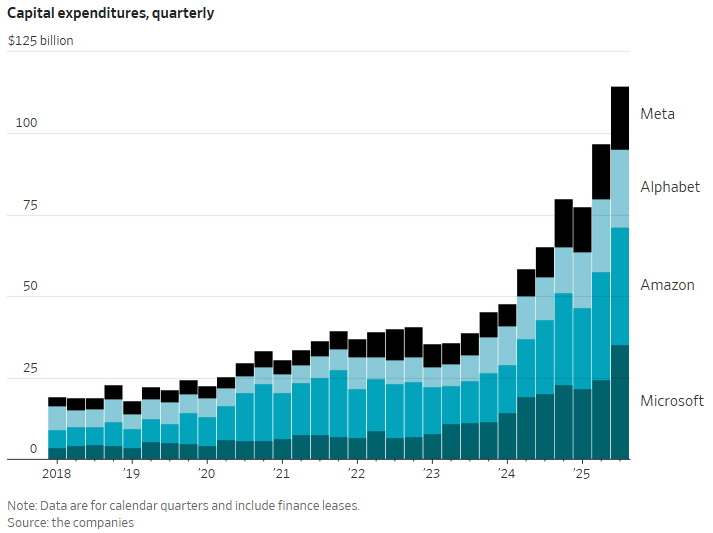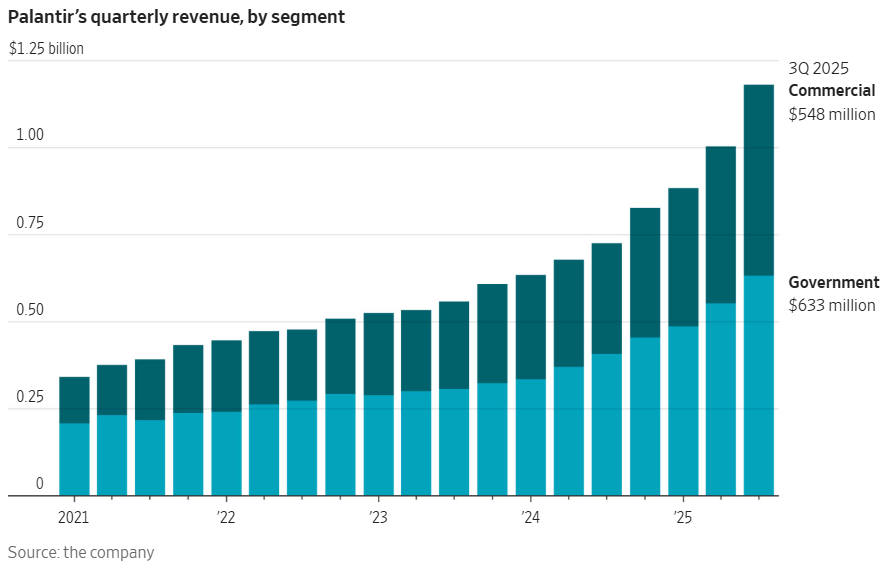Investors are well-aware that the players carrying us through this AI race right now likely won’t be the last ones left standing at the finish line. There are, however, signs that a rotation might already be underway.
The Magnificent Seven group of tech stocks — which includes Nvidia, Apple, Amazon, Alphabet, Microsoft, Meta Platforms, and Tesla — have been widely held as the top dogs in the AI revolution.
They’re up a meteoric 28% this year on a cap-weighted basis. Awesome, right?
But if you look at the performance of other AI players that aren’t a part of the Magnificent Seven, their performance suddenly seems to pale in comparison.
For example, Palantir shares have added 135% in 2025, Broadcom has gained 51%, CoreWeave has added 94%, AMD has rallied 93%, Micron has jumped 183%, and Intel has surged 90%.
Not a single Magnificent Seven stock’s performance is as good as the performance of the AI players mentioned above. Even the best performer in the group, Alphabet (GOOG), has “only” added 47% this year, which by the way, marks a huge reversal from its performance last year.
Data suggest that even institutional investors feel tired lately of the Magnificent Seven. According to a Bank of America fund manager survey for October, 43% of respondents ranked long gold as the most crowded trade, followed by 39% for long Magnificent Seven. In September, it was the opposite, with 42% respondents saying long Magnificent Seven was the most crowded trade and 25% marking long gold.
Of course, much of that may have to do with investors being anxious that circular AI investments are masking a bubble.
When the top 10 stocks make up about 40% of the S&P 500’s market cap, it’d be unusual if investors didn’t feel nervous.
In addition to that, many feel uneasy about stocks extending this bull run because they look too expensive. Valuation measures from forward price-to-sales ratio to the Buffet indicator are at levels higher than the ones seen during the height of the dot-com bubble, which has further stoked fears of a bubble.
Some of those concerns took center stage this week when influential executives — Goldman Sachs’ David Solomon and Morgan Stanley’s Ted Pick — said that stocks could see declines upward of 10% in the next 12-24 months.
In the grand scheme of things, corrections of 10% are considered by many to be healthy for longer-term returns, but still, the concerns voiced by Solomon and Pick underscore just how hesitant investors are right now in this AI-driven bull run.
Some investors are going one step further and outright betting on declines. Michael Burry, who famously predicted the 2007-09 recession, revealed this week that he bought puts that will make him money if Nvidia and Palantir shares fall.
So the question becomes, how do investors navigate this uncertain era for the stock market and try to make sure they pick the stocks that will lead the next leg of the AI revolution?
Priced for Perfection
Except for Nvidia (NVDA), most of the Magnificent Seven group has already reported third-quarter earnings. Profits are on pace to rise 23% in the third quarter from a year ago, compared to 13% for the rest of the 493 companies in the S&P 500 index. The broader index is expected to report earnings growth of 15%.
It should be noted, however, that at the company level, the top four contributors to the increase in earnings growth rate for the broader index since Sept. 30 includes only four of the Magnificent Seven companies — Alphabet, Amazon, Microsoft, and Apple. And one member — Meta — is responsible for the largest detraction from the increase in the earnings growth rate over that same period.

The takeaway is that even for Magnificent Seven players that have demonstrated AI enthusiasm, investors’ response is complex.
Let’s start with the problem child, Meta (META). Its shares fell 11% a day after its third-quarter earnings on Oct. 29, which was surprising because the stock was flying high for most of the year.
The company noted record revenue in the latest quarter and beat expectations, but it warned that total expenses would “grow at a significantly faster percentage rate in 2026 than 2025” mostly because of AI infrastructure costs.
That in and of itself isn’t what spooked investors. What scared them was that Meta doesn’t have a clear path on how it’s planning to make money from all this investment.
Those worries were echoed by Nat Schindler of Scotiabank in a report following the call, where he said the company “will need to see a bevy of new revenue streams to validate their capex ramp.”
Meta’s not alone in increasing its capex. Alphabet, Amazon, and Microsoft are also planning to increase their spending.

Amazon’s (AMZN) earnings drew a complete opposite reaction from investors. Its shares shot up 9.6% a day after its earnings report.
That was largely due to the robust performance and re-acceleration of its cloud-computing business, Amazon Web Services. The market was relieved to see third quarter AWS revenue growth jump 20% from a year ago, the largest percentage increase since 2022. It typically accounts for a little more than 15% of Amazon’s total revenue, but the segment is a huge profit engine, making up roughly 60% of the company’s total operating income, according to Reuters.
And investors’ positive reception to Amazon earnings goes to show that it’s successfully navigating the artificial intelligence investment cycle, as much of its growth is attributed to strong demand for computing power for AI workloads and core infrastructure.
Its shares are now up 11% this year.
Apple (AAPL), too, noted positive reception for its earnings. It reported that the iPhone revenue of $49 billion came in below expectations, but the key catalyst for the stock, which has been hovering near record highs, was the company’s optimistic guidance for the holiday quarter, projecting 10-12% total revenue growth. That signaled confidence in the accelerating upgrade cycle.
But its spending on AI, though forecast to increase in the fourth quarter, is a drop in the bucket compared to that of its rivals.
Among Magnificent Seven, all investors are still waiting for now is Nvidia (NVDA), which will release its earnings on Wednesday, Nov. 19. Its shares are up 40% this year, and it’s been busy announcing deals with just about everybody these days. Recent ones encompass South Korean conglomerates Samsung Electronics and Hyundai Motor Group, along with Nokia, Uber, and Stellantis.
As a chipmaker, Nvidia is what underpins the whole AI revolution. But as our First to Market note explained this week, even Nvidia isn’t immune from potentially losing market share, especially if it’s not allowed to sell its more advanced Blackwell chips in China.
Those reasons highlight why investors’ focus should intensify on where the next generation of AI wins will come from.
The Other Contenders
Palantir (PLTR) has been exemplary this year. The rapid commercial adoption of its Artificial Intelligence Platform (AIP) by large, non-government enterprises has led to accelerated revenue growth and margin expansion in the third quarter.

Its shares still tumbled 7.9% on Tuesday after earnings because of valuation concerns. It trades at 189.33 times forward earnings. In comparison, Nvidia trades at 30.43. Burry, revealing that he’s betting on Palantir’s shares going down, also hit its share-price performance.
Chief Executive Alex Karp called moves by short sellers like Burry “market manipulation” on CNBC. Karp called the positions “super triggering” and said they are “shorting one of the great businesses of the world.”
The thing about Palantir is that its moat as a trusted, embedded partner for national security and allied governments can’t be easily replicated. It provides a specialized, full-stack AI decision platform, not just general cloud computing or consumer AI.
In Broadcom’s (AVGO) case, as a custom-chip business, it captures value at two critical points: the high-margin software stack (through VMware subscriptions) and the custom hardware layer (ASICs/networking). This combination creates a resilient, diversified business model.
Some analysts estimate that its recent deal with OpenAI — where they plan to deploy 10 gigawatts of custom AI chips and computing systems over the next few years — could help generate well in excess of $100 billion of additional revenue in the next three to four years.
Broadcom’s market capitalization has ballooned to $1.7 trillion, doubling from last year.
AMD (AMD), another chip maker, has basically established itself as a credible No. 2 player with its MI300X and the upcoming MI450 series.
Its GPUs offer compelling performance-per-dollar, driving massive order book growth from hyperscalers seeking supply diversification away from Nvidia. Its deal with OpenAI for up to six gigawatts of computing power has helped the shares rally 44% so far this quarter.
Its significantly smaller market cap compared to its rival Nvidia means it offers substantially higher potential percentage returns if it captures even a little larger fraction of the AI market share.
Meanwhile, Micron (MU) is in a league of its own. Its shares hit fresh all-time highs this week. Its leading the “Memory Supercycle” through its advanced High-Bandwidth Memory (HBM) technology, which is indispensable for training AI models.
The demand for HBM is driven by all Magnificent Seven members building AI models. It sits at the foundation of the AI revolution, making it less vulnerable to the competitive success of any single AI software or GPU architecture.
Intel (INTC) has been turning things around for itself, too. Fueled by massive U.S. government backing and strategic alliances (like the $5 billion Nvidia investment), the 56-year-old company is looking to regain leadership in chip manufacturing via its Intel Foundry Services.
Besides, it’s the only U.S.-based, end-to-end chip manufacturer, making it a national security asset. Its foundry goal is aimed at providing domestic, resilient manufacturing capacity, a structural imperative that benefits from geopolitical supply chain de-risking away from Asia.
CoreWeave (CRWV) sits on the opposite end of that. It’s the newcomer on the block, and only became publicly traded this year. Its rapid rise — backed by investors and partners like NVIDIA, OpenAI and Microsoft (MSFT) — shows the growing demand for highly specialized infrastructure. However, investors also need to weigh its heavy leverage (significant off-balance sheet data center lease obligations) and current lack of profitability against its forecast growth trajectory.
Conclusion
As we’ve written about before, the Magnificent Seven are like the elder child, where most of the time they behave themselves, but every now and then, the pressure of being perfect leads to cracks. That’s one of the key reasons why the AI bull cycle is accelerating outside the Magnificent Seven’s orbit, validating a diverse group of companies building structural moats. Keep in mind, however, that AI is still in its infancy. So it’s entirely possible that other players, some of which likely don’t even exist yet, will take over. But since AI remains a multiyear supercycle, we will only discover them in the years to come.
As always, Signal From Noise should not be used as a source of investment recommendations but rather ideas for further investigation. We encourage you to explore our full Signal From Noise library, which includes deep dives on the race to onshore fabrication, AI Merry-Go-Round, space-exploration investments, the military drone industry, the presidential effect on markets, ChatGPT’s challenge to Google Search, and the rising wealth of women. You’ll also find a recent update on AI focusing on sovereign AI and AI agents, the TikTok demographic, and the tech-powered utilities trade.



